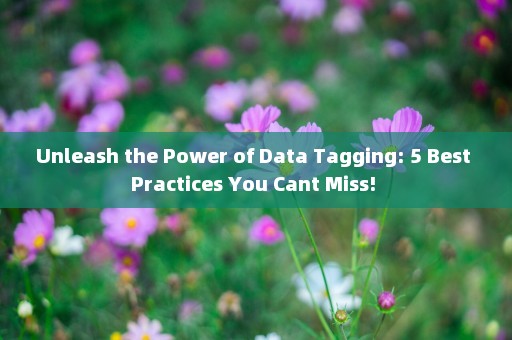Imagine walking into a massive library where every book is meticulously organized, tagged, and easily accessible. As a specialist in the field of data tagging, I've spent years fine-tuning this art, creating an intricate web of labels that transform chaos into coherence. Today, I'm going to share with you some of the best practices that have revolutionized my approach to data tagging.

Start with a Solid Foundation: Define Your Data Model
Before you dive into the tagging process, it's crucial to establish a strong foundation. A well-defined data model serves as the blueprint for your tagging efforts. It ensures consistency, accuracy, and scalability. Here's how to build a solid data model:
-
Identify Your Data Entities: Determine the key entities within your data. These could be customers, products, transactions, or any other relevant categories.
-
Define Attributes: For each entity, specify the attributes that describe it. For example, a customer entity might include attributes like name, email, and phone number.
-
Establish Relationships: Identify how different entities are related. This helps in understanding the context and dependencies within your data.
Embrace the Power of Standardization
Consistency is the key to effective data tagging. Standardizing your tags ensures that everyone in your organization understands and follows the same conventions. Here are some tips for standardization:
-
Use Clear and Descriptive Tags: Tags should be self-explanatory, making it easy for others to understand their purpose. Avoid using ambiguous terms or abbreviations.
-
Develop a Tagging Glossary: Create a comprehensive list of tags with their definitions. This serves as a reference guide for your team and helps maintain consistency.
-
Enforce Naming Conventions: Establish naming conventions for tags, such as using lowercase letters, underscores for spaces, and acronyms when appropriate.
Implement a Hierarchical Tagging Structure
Organizing your tags in a hierarchical structure allows for better categorization and easier data retrieval. Here's how to implement a hierarchical tagging system:
-
Identify Parent Tags: These are the broader categories that encompass multiple subcategories. For example, "Marketing" could be a parent tag for "Email Marketing" and "Social Media Marketing".
-
Create Child Tags: These tags represent more specific subcategories under the parent tags. They help in drilling down to the desired level of detail.
-
Use Nested Tags: Allow tags to be nested within each other, creating a tree-like structure. This enables complex categorization while maintaining clarity.
Leverage the Magic of Automation
Manual data tagging can be time-consuming and error-prone. Leveraging automation tools can significantly enhance your tagging efficiency. Here's how to make the most of automation:
-
Use Machine Learning: Implement machine learning algorithms to automatically suggest tags based on existing data patterns. This reduces manual effort and improves accuracy.
-
Set Up Rules-Based Tagging: Create predefined rules that automatically apply tags based on specific criteria. For example, you can automatically tag all transactions above a certain value as "High-Value Transactions".
-
Monitor and Refine: Regularly review the automated tagging process to ensure accuracy. Adjust the rules and algorithms as needed to improve results.
Don't Overlook Data Governance and Security
Proper governance and security measures are essential to protect your tagged data. Here are some best practices to consider:
-
Implement Access Controls: Ensure that only authorized personnel can access and modify tags. This helps maintain data integrity and prevents unauthorized changes.
-
Regularly Backup Your Data: Regularly back up your tagged data to prevent loss in case of system failures or accidental deletions.
-
Monitor and Audit: Keep track of tag modifications and access logs to identify any suspicious activities or unauthorized changes.
Conclusion
Data tagging is a powerful tool that, when done right, can transform your data into a valuable asset. By following these best practices, you'll create a well-organized, easily accessible, and secure data tagging system. Remember, the key is to start with a solid foundation, embrace standardization, implement a hierarchical structure, leverage automation, and prioritize data governance and security. Happy tagging!
Post a comment

Comment List